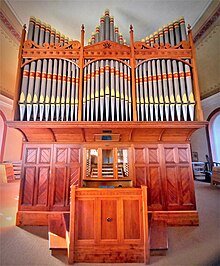Harrison & Harrison

Harrison & Harrison Ltd is a British company that makes and restores pipe organs, based in Durham and established in Rochdale in 1861. It is well known for its work on instruments such as King's College, Cambridge, Westminster Abbey, and the Royal Festival Hall.[1][2][3]
History of the firm
Thomas Harrison established an organ building company in 1861 in Rochdale, then moved to Durham in 1872. The company was moderately successful but did not achieve real success until 1896 when Thomas's sons Arthur and Harry took over. Harry designed the organs and Arthur proved to be a particularly gifted voicer, resulting in commissions for rebuilds of several great organs including Durham Cathedral, the Grand Organ at the Royal Albert Hall and new commissions including Westminster Abbey, and Rossall School (1925). Between 1890 and 1996 Harrisons was located on Cross Street (now Hawthorn Terrace), Durham in a former paper mill.[4] The building is now called Harrison House.
Arthur Harrison died in 1936 and Harry retired in 1946. The company passed to Harry's son Cuthbert. The firm was led by Mark Venning from 1975. David Hirst joined as Deputy Managing Director in 2008 and led the firm as Managing Director from 2009. In 2010, Mark Venning returned to maintain operations until the arrival of Dr Christopher Batchelor in 2011. The firm was run by Dr Batchelor from 2011 to June 2017.[4] In October 2017, Andrew Reid left his job as Director of the Royal School of Church Music and joined Harrisons as the new managing director. In 2022, Andrew Scott took over as managing director, the first to work his way up through the firm from an apprenticeship. Mark Venning remains active as chairman.
In the postwar period Harrisons contributed significantly to the renaissance of classical organ building; their instruments for the Royal Festival Hall (designed in close collaboration with Ralph Downes) and St Albans Abbey (for Peter Hurford) are of particular importance. To those two landmark instruments may be added the organs of Coventry Cathedral, the chapel of Somerville College, Oxford and St George's Chapel, Windsor Castle, all of these instruments being built during the tenure of Cuthbert Harrison and under his direction.[4]
A history of the firm, titled The Harrison Story, was published in 1974 by Laurence Elvin.[5]
References
- ^ "The National Pipe Organ Register - NPOR". npor.org.uk. Retrieved 21 August 2019.
- ^ "The National Pipe Organ Register - NPOR". npor.org.uk. Retrieved 21 August 2019.
- ^ "The National Pipe Organ Register - NPOR". npor.org.uk. Retrieved 21 August 2019.
- ^ a b c "History – Harrison & Harrison Ltd". Retrieved 21 August 2019.
- ^ Elvin, Laurence (1977). The Harrison Story: Harrison and Harrison, Organ Builders, Durham. ISBN 9780950004945.
